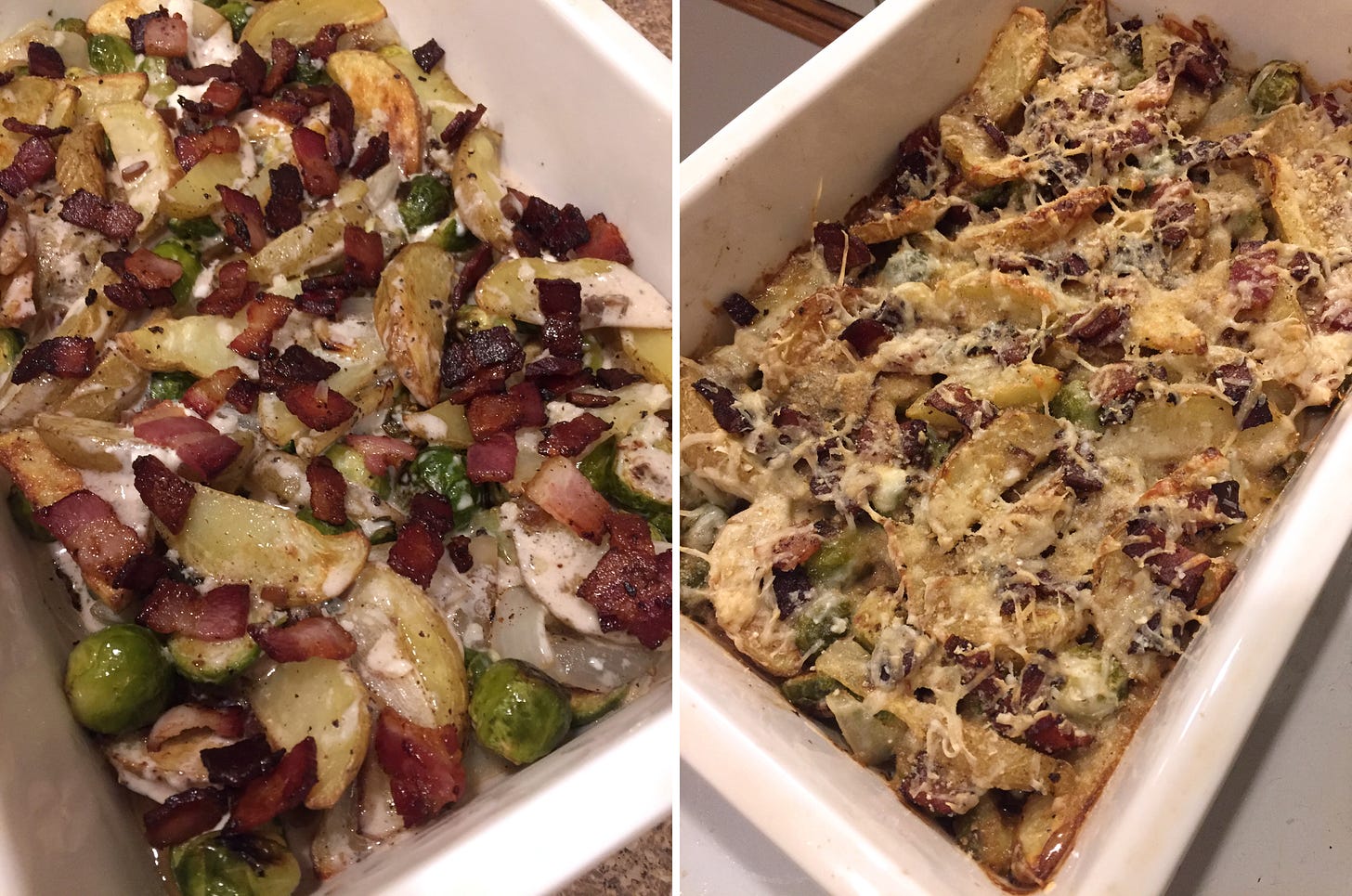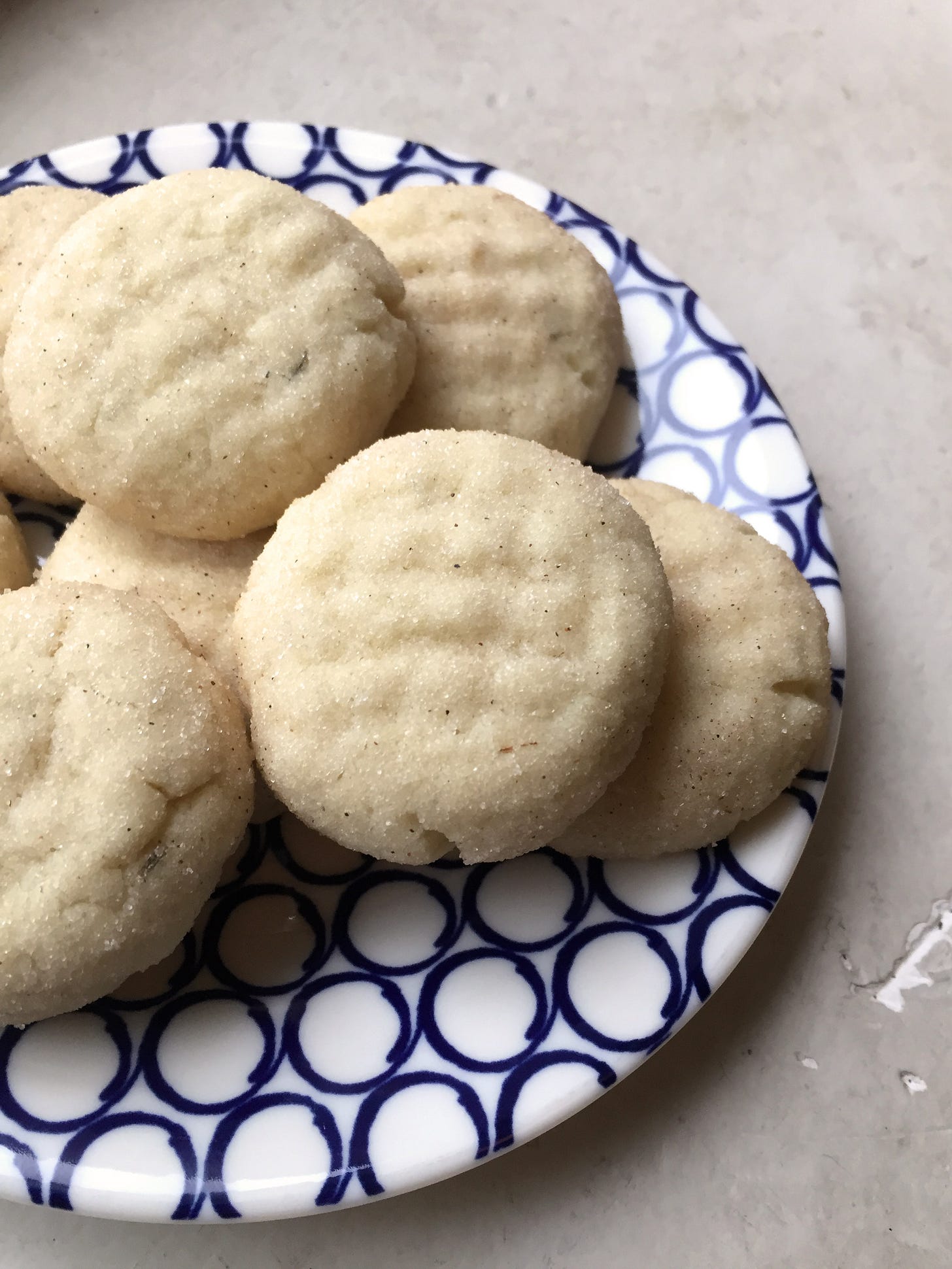Season’s greetings from this cursed gravy boat we saw last weekend at the thrift store. I think my lethargy of the previous week has been transformed this week into a quiet, distilled rage about how it’s constantly dark and raining, because I found myself filled with domestic desires to clean and do and create and especially, eat. So this week had some deeply satisfying dishes of light to moderate effort, because cooking felt like fun again instead of work! It is still winter though, just so you know to be prepared for the amount of cheese, cashew cream, and other rich elements you’re about to consume with your eyes.
Because I opened that pack of bacon last week for the carbonara, Jeff and I then had to be responsible for eating a pound of bacon within the recommended seven days. We made some breakfast sandwiches and BLTs, and to finish off the rest, I altered a recipe from a cookbook I got for my birthday that I’m really excited about, Six Seasons by Joshua McFadden. The recipes in it are organized based on when certain vegetables are ripe and abundant, which really appeals to my methods of deciding what to cook. There were still a handful of brussels sprouts in the garden— extra sweet from the weekend’s frost— and the book had a delicious-sounding recipe for a roasted sprout & prosciutto gratin with gruyère.
Obviously I took the recipe as more of a flavour guide than strict direction, but this was a great ‘use that thing up’ dinner: not only did it use the bacon and sprouts, but I also added some potatoes that had started to sprout, and a few remaining tablespoons of brown butter vinaigrette. It’s a bit involved due to par-roasting the sprouts, onions, and potatoes first, and then adding everything to a baking dish with the sauce and cheese. But even though it creates more dishes, it takes less time this way than a traditional gratin, and the roasting step provides a nice caramelized flavour you would normally only get at the edges of a gratin instead of throughout. I also had to cook the bacon first, which you wouldn’t need to do with prosciutto. But holy wow was this ever delicious— I was expecting leftovers, but we finished the entire pan between the two of us. It felt like a full meal because of the potatoes, but I think if you make it with just the sprouts you’d probably want something else to go with it. One final tip: add the breadcrumbs in the last five minutes of baking instead of after it comes out of the oven, so that they’ll be toasted!
In further roasted-vegetables-and-carbs news, on Monday I got around to making the famed cauliflower pasta from everyone’s problematic fav, Alison Roman (I had been waiting for cauliflower to stop being $8-9 a head). I’ve recommended this recipe to people without even having tried it, just because it looked and sounded amazing, so I was thrilled to finally get to eat it. This was one time where the plentiful comments on the recipe were actually helpful: many people confirmed my suspicion that it would take an eon for a whole sliced cauliflower to break down and brown in a frying pan, not the 12-15 minutes specified in the recipe. I opted to slice the cauliflower and roast it on a sheet pan at 400°F for 20 minutes instead, after drizzling with oil and sprinkling with salt and hot paprika. It came out nicely caramelized in places and ready to break off from the cores, and any core bits that didn’t come apart easily I just chopped roughly before adding to the pan.
Pre-roasting the cauliflower doesn’t necessarily save time because it still takes 20 minutes, but it means you can do other things while it’s in the oven, and the sauce comes together more quickly. I made the pecorino breadcrumbs while the cauliflower was roasting, and while mine didn’t really make “granola-like clusters” (maybe because I used panko instead of larger, homemade crumbs) they were still extremely good— crispy, salty, and with a nice bite from the cheese. They’re absolutely essential for texture in this creamy dish, and the recipe makes loads. I put easily 1/4 cup on my bowl of pasta and it seemed to hardly make a dent in them. I’m pleased to report that this was indeed fabulously creamy, crunchy, and satisfying. I did wish for a bit more lemon flavour, even though I’d also added juice, so next time I think I’d put a little zest in the breadcrumbs, too. I garnished with parsley, because I was not going outside in the dark and rain to pick chives.
On Tuesday, a terrible thing happened. I remembered I needed to make chickpeas for the elaborate dinner I’d planned, went into the kitchen, and realized Jeff had set it up that morning to start making yogurt (a 24-hour process). I used to have some emergency cans of beans, but it had been so long since I had not used dried beans that I hadn’t bothered to replenish them. So I hurriedly googled how to cook beans if you don’t have time to soak them overnight, and luckily you can “quick soak” them: boil for 5 minutes, and then let them soak in the hot water for an hour before draining and cooking. I have to say the time involved even in a quick soak method makes me very happy that I can use the instant pot for this under normal circumstances.
Anyway, I was making the vegan malai kofta from Isa Does It, which I mentioned a few weeks ago when I made the Tejal Rao kofta curry. (I found the Isa recipe published online in case anyone who doesn’t have the book wants to try, but unfortunately it’s in the Guardian: fair warning before you click the link.) It had been awhile since I’d made this, probably because it requires a little forethought and a not insignificant amount of effort, but it was every bit as incredible as I remembered. This is one of the few curries I can make at home that actually tastes as rich and delicious as a restaurant’s, and I think the secret is that the sauce involves cashew cream and coconut milk. When I made this for the first time, reading through the ingredients I thought that seemed excessive, but it is not. It is perfect.
In the book, Isa says she prefers to shred the zucchini by hand to get smaller pieces instead of using the shredder on the food processor, presumably so the kofta hold together better. It’s no secret that prep is my least favourite part of cooking, and I hate grating things by hand more than just about any kitchen task except maybe peeling potatoes, so I use the food processor and it’s not a problem. Then, since I’d already used the food processor, I could comfortably use it for my other lazy trick with curries like this: pulsing together the onion, ginger, and garlic to get a chunky paste you can cook all at once. I also added a jalapeño this time, which I recommend if you like your sauce spicy (the recipe is mild otherwise).
The fridge time for the kofta mixture is necessary to let the zucchini release its moisture so the mixture’s not too crumbly to work with, but the recipe is nicely set up so you can make the sauce in the meantime, and then just keep it warm while you form and fry your kofta. I bet they would work fine in the oven like the Tejal Rao recipe, too. They come out crispy and brown on the outside, and inside there are texturally satisfying bits of almond amid the softness of the spiced chickpeas and zucchini. I completely forgot to add the peas to the sauce at the end, but it’s so flavourful and lovely overtop of the rice and kofta I didn’t notice until just now, while writing this. If you’ve got a little over an hour to make an absolutely killer dinner, I can’t recommend this recipe enough.
Other items of note this week include, as a side for a turkey club sandwich on sourdough, a salad of kale and roasted brussels sprouts in Caesar vinaigrette with parmesan. Kale caesars enjoyed a heyday in restaurants not too long ago (or is it still happening?), but the trouble is that a lot of dressings just aren’t robust enough to stand up to the hardy kale. This dressing is meant for a grilled romaine so it is powerful, and we agreed that while the sandwich was good, the salad was excellent.
I also found myself making lavender snickerdoodles on Tuesday night at 8:30pm, because I realized I had to bring my secret Santa gift to work on Wednesday so that the recipient could pick it up before Friday when we have our Zoom holiday party. I’ve included the recipe below, which exists on a card in my recipe box after I made them initially by smashing together a friend’s recipe and some other, and kept forgetting which elements came from which whenever I tried to recreate them. I encourage you to try it— they are sweet, light, and fragrant, and I delight every year (except this year, I guess) in seeing that people enjoy them enough to still have room for 2 or sometimes 3 after Christmas dinner.
LAVENDER SNICKERDOODLES
1½ cups all-purpose flour
¾ tsp salt
½ tsp baking soda
1 tsp lavender flowers, crushed with a mortar & pestle
½ cup vegetable oil
½ cup white sugar
1 egg (vegan sub: 1 tsp potato starch + 2 tbsp soy milk)
1 tsp each vanilla and almond extracts (or use all vanilla)
cinnamon sugar to coat (I just eyeball it but it’s around 1 tsp cinnamon to ¼ cup sugar)
Mix together the flour, salt, baking soda, and lavender in one bowl. In another, whisk the oil and sugar until thick and gooey. Add the egg and extracts and whisk to combine, then mix in the dry ingredients with a spoon or rubber spatula. Pat together if the dough starts to crumble, then refrigerate for 30 minutes. (Preheat the oven to 350°F at some point during this time).
Form the dough into roughly 1” balls with your hands (gently so they don’t break apart), and roll in the sugar. Place on baking sheets (parchment-lined or not, doesn’t matter) and flatten slightly with a fork or your fingers. Bake 7-9 minutes, until they spread out a little and are browned on the bottom, but still seem underdone on the top. Let rest on baking sheet for 5 minutes so they don’t collapse when you move them, then transfer to a cooling rack. Makes about 2 dozen (I usually get 1 bonus cookie).
Notes: I like my baking on the salty side, and I also use Diamond kosher salt, which is a bit less salty than some others, so you may want to reduce to ½ tsp if using another salt. If you don’t have a mortar & pestle or spice grinder, you can crush the lavender by placing it in a ziploc bag and using a rolling pin (or empty wine bottle) on it. You can also just leave it out if you want original flavour snickerdoodles instead.
Thanks for reading— if you enjoyed this newsletter, please share it with someone new! I’ll be taking a break next week, but I’ll be back in your inbox on New Year’s day. If you’re celebrating, I wish you all a peaceful and safe holiday with whatever joy you can find, and I look forward to hearing about everyone’s non-traditional and/or uncommonly tiny holiday feasts.
In the meantime, I had to see it and now so do you: the king’s hand.








